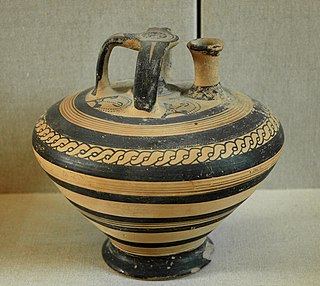
The three-age system is the periodization of human prehistory into three time-periods: the Stone Age, the Bronze Age, and the Iron Age, although the concept may also refer to other tripartite divisions of historic time periods. In history, archaeology and physical anthropology, the three-age system is a methodological concept adopted during the 19th century according to which artefacts and events of late prehistory and early history could be broadly ordered into a recognizable chronology. C. J. Thomsen initially developed this categorization in the period 1816 to 1825, as a result of classifying the collection of an archaeological exhibition chronologically – there resulted broad sequences with artefacts made successively of stone, bronze, and iron.

Chronology is the science of arranging events in their order of occurrence in time. Consider, for example, the use of a timeline or sequence of events. It is also "the determination of the actual temporal sequence of past events".
In archaeology, lithic analysis is the analysis of stone tools and other chipped stone artifacts using basic scientific techniques. At its most basic level, lithic analyses involve an analysis of the artifact's Morphology (archaeology), the measurement of various physical attributes, and examining other visible features.
Typology is the study of types or the systematic classification of the types of something according to their common characteristics. Typology is the act of finding, counting and classifying facts with the help of eyes, other senses and logic. Typology may refer to:

An artifact or artefact is a general term for an item made or given shape by humans, such as a tool or a work of art, especially an object of archaeological interest. In archaeology, the word has become a term of particular nuance and is defined as an object recovered by archaeological endeavor, which may be a cultural artifact having cultural interest.
An archaeological culture is a recurring assemblage of types of artifacts, buildings and monuments from a specific period and region that may constitute the material culture remains of a particular past human society. The connection between these types is an empirical observation, but their interpretation in terms of ethnic or political groups is based on archaeologists' understanding and interpretation and is in many cases subject to long-unresolved debates. The concept of the archaeological culture is fundamental to culture-historical archaeology.
Archaeology is the study of human activity in the past, primarily through the recovery and analysis of the material culture and environmental data that they have left behind, which includes artifacts, architecture, biofacts and cultural landscapes.

Stratigraphy is a key concept to modern archaeological theory and practice. Modern excavation techniques are based on stratigraphic principles. The concept derives from the geological use of the idea that sedimentation takes place according to uniform principles. When archaeological finds are below the surface of the ground, the identification of the context of each find is vital in enabling the archaeologist to draw conclusions about the site and about the nature and date of its occupation. It is the archaeologist's role to attempt to discover what contexts exist and how they came to be created. Archaeological stratification or sequence is the dynamic superimposition of single units of stratigraphy, or contexts.
In archaeology, seriation is a relative dating method in which assemblages or artifacts from numerous sites in the same culture are placed in chronological order. Where absolute dating methods, such as radio carbon, cannot be applied, archaeologists have to use relative dating methods to date archaeological finds and features. Seriation is a standard method of dating in archaeology. It can be used to date stone tools, pottery fragments, and other artifacts. In Europe, it has been used frequently to reconstruct the chronological sequence of graves in a cemetery.
The Angel phase describes a 300–400-year cultural manifestation of the Mississippian culture of the central portions of the United States of America, as defined in the discipline of archaeology. Angel phase archaeological sites date from c. 1050 - 1350 CE and are located on the northern and southern sides of the Ohio River in southern Indiana, such as National Historic Landmark Angel Mounds near present-day Evansville; northwestern Kentucky, with Wickliffe Mounds and the Tolu Site; and Kincaid Mounds State Historic Site in Illinois. Additional sites range from the mouth of Anderson River in Perry County, Indiana, west to the mouth of the Wabash in Posey County, Indiana.
Sequence dating, an archaeological relative dating method, allows assemblages to be arranged in a rough serial order, which is then taken to indicate time. Sequence dating is a method of seriation developed by the Egyptologist Sir William Matthew Flinders Petrie. By linking styles of pottery with different time periods, he was able to establish the relative chronology of the site.

Pottery was produced in enormous quantities in ancient Rome, mostly for utilitarian purposes. Some of this pottery has been uncovered into the 21st century in the former territory of the Roman Empire, as well as in other parts of the world, especially in waste mounds such as Monte Testaccio.
Yuchanyan is an early Neolithic cave site in Dao County (Daoxian), Hunan, China. The site yielded sherds of ceramic vessels and other artifacts which were dated by analysis of charcoal and bone collagen, giving a date range of 17,500 to 18,300 years old for the pottery. The pottery specimens may be the oldest known examples of pottery.
Benjamin Irving Rouse was an American archaeologist on the faculty of Yale University best known for his work in the Greater and Lesser Antilles of the Caribbean, especially in Haiti. He also conducted fieldwork in Florida and Venezuela. He made major contributions to the development of archaeological theory, with a special emphasis on taxonomy and classification of archaeological materials and studies of human migration.

In archaeology, morphology is the study of the shape of artefacts and ecofacts.
To understand past cultures archaeologists analyze many artifacts. Pottery proves to be of most importance to the archaeological record. Pottery is durable and even allows its broken fragments to withstand time, which would otherwise decompose other artifacts. More importantly, the style of pottery often changes through time, and shifts in shape, size, or decoration can be used to resolve the age of the artifact and/or site. Furthermore, though pottery is common, different cultures had their own distinct styles that can be used to determine its similarities or differences with one another. Therefore, even fragments of pottery can reconstruct many facets of past cultures.
Chronological dating, or simply dating, is the process of attributing to an object or event a date in the past, allowing such object or event to be located in a previously established chronology. This usually requires what is commonly known as a "dating method". Several dating methods exist, depending on different criteria and techniques, and some very well known examples of disciplines using such techniques are, for example, history, archaeology, geology, paleontology, astronomy and even forensic science, since in the latter it is sometimes necessary to investigate the moment in the past during which the death of a cadaver occurred. These methods are typically identified as absolute, which involves a specified date or date range, or relative, which refers to dating which places artifacts or events on a timeline relative to other events and/or artifacts. Other markers can help place an artifact or event in a chronology, such as nearby writings and stratigraphic markers.
There are two main approaches currently used to analyze archaeological remains from an evolutionary perspective: evolutionary archaeology and behavioral ecology. The former assumes that cultural change observed in the archaeological record can be best explained by the direct action of natural selection and other Darwinian processes on heritable variation in artifacts and behavior. The latter assumes that cultural and behavioral change results from phenotypic adaptations to varying social and ecological environments.
This page is a glossary of archaeology, the study of the human past from material remains.
In Small Things Forgotten: An Archaeology of Early American Life was originally published in 1977 by anthropologist James Deetz. The book presents the idea that small objects can play big parts in an individual's life, and should therefore not be taken lightly in an archaeological investigation. The book is one of Deetz's most popular, and has become a staple piece of literature for those studying historical archaeology.






